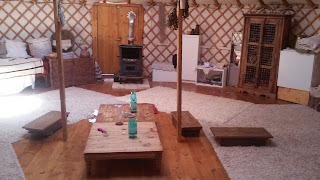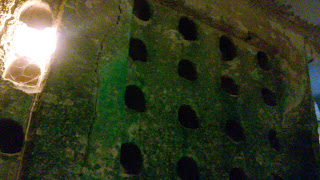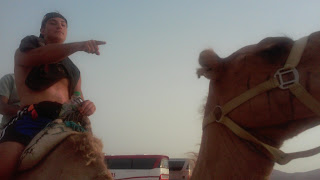WWOOFing, or rather as it is better known as WWOOF, stands for World Wide Opportunities on Organic Farms, and Willing Workers On Organic Farms, is an international network that exists worldwide in 99 countries.
Boy that was a bit of a wordy explanation. But it needs to be said, because every time I tell someone I am currently WWOOFing, they go 'Huh'? or for the ones who don't I'm assuming believe I'm acting like a dog somewhere.
Quite the opposite; It is a system where, basically, I work for a person who is building a farm or something of the like, in exchange for room and board, and in some places also transportation. It depends on how friendly the family is and your relationship with them.
I've been here near Beit Shemesh in Matava Matta, a village similar to a Kibbutz (still trying to figure out how much different they are, but it seems by very little.). So far the experience has been exceptional. At the very least very interesting.
To start with I will refer to my host family by their first names only; Josef and Rachel. Josef hails from France, whereas Rachel comes from Mexico. First time I ever met a Mexican Jew. We've had some good conversations about missing Hispanic food. I'm still looking for Nachos in Israel; wish me luck on that.
They live in a Yurt; which was pretty surprising. They in the past had a very large house which was a spiritual center which not only housed animals, but operated in teaching Jewish perspective on how to meditate. They eventually decided to put into action their dream, packed up their bags and began a project to start an organic farm a bit away from where they used to live atop a hill.
Here is the yurt;
A closer view;

It looks modest, but it's awesome inside;

What I'm not showing in the interior photos is the hallway between the two yurts that leads to a bathroom as well as storage closet, and their very large bedroom.
Y'know, respecting some of the privacy.
The yurt is also hooked up to an electric line, as well as water, and even has wifi. Even though they may live relatively off the grid, those of us who are volunteering (such as the New Yorker and UK jews I joined here) are not.
They also have pets! That's their dog Leo, as well as one of the three kittens. I took these photos during the hottest part of the day today around 3 P.M. so these two are doing their best to just sleep through the heat. Can't blame them.
There are also quite a few chickens.
Here is the tent where I sometimes sleep; I split my time between there and the room they rent which is pretty nearby.
The space in front is actually the garden they will be growing. It has enough room to sustain their family year round. Because this is the seventh year in the Hebrew calendar; Shmita, and is the year of rest. Where slaves are freed, and the land is allowed to refresh. In fact, it is completely permissible to pick fruits and vegetables from gardens and farms (where they observe Jewish law) where it is growing without it being considered stealing or trespassing. It is a year of giving. For example, there is a pomegranate tree
See, Pomegranate. Anyway, I pass it everyday, and if I want to, even though it is growing in the neighbors yard, it is completely OK for me to pick that last pomegranate. So that is why the garden has nothing growing in it presently; the Shmita won't end until September 2015, which is when the first plantings in their project will have begun.
So thus far this is what we have done this week;
Finished a pond, digging it down which in its own right was cool. Israel is filled with history, like literally at this point I'm assuming that within the hills are the remains of houses long since buried. As we dug the pond we began to notice that a lot of what we were digging through was solid rock. It was only when we started digging up pottery shards, and noticed that a lot of the stones were squarish, and had right angles that we were accidentally excavating an ancient house.
So I got my first introduction to firsthand archaeology.
We filled the holes we had dug with Pumice to filter the water discharged from their house. In September this will become a fish pond they can harvest fish from.
 |
| 2000 years ago this was somebody's house. |
The next day we built their campfire that will be hosting a singing group over the next week;
We had so many rocks from when digging the pond we had to do something with them. The land we dug was approximately 35% stone, 60% dirt, and 5% grass. Of the stone, about 10-15% I'm convinced was somebody's house a long, long time ago.
Breakfast, lunch and dinner are served, and it is very well cooked. Unfortunately for me it is also Vegan, so I've had to scrounge to get cheese, which I managed to. They don't expect their children to be strictly vegan, so they didn't mind at all. I keep it in the room that is adjacent, which is more like a very small apartment.
We spend each meal talking to each other; Josef, who is very spiritually active especially with the Kabbalah has found a kindred spirit with me, and we engage in long discussions while walking, working or at the table over how we both have very similar views on life and morality, the world and people, yet how my views stem from Buddhism and his from Judaism. Just an hour before writing this post I commented that it is good our views our complimentary yet come from different sources- this way they can better support one another because of the difference. Sometimes difference can mean additional, as is the case here.
But enough philosophy; Today is Shabbat, and I got to take part in a very personal tradition the family holds for how they celebrate it. I then stuffed myself silly on squash soup and Tofu and mushrooms. I didn't say I wouldn't eat Vegan, just that I really, really miss meat, and its only been five days.
If you're looking for a cool way to explore a country, especially Israel, WWOOFing is a great way to go about it.
And if you're looking for a spiritually rewarding experience as well, hit up farm256.
As a bonus, here are the hills you can see from the homestead Josef has set up.
And A view from just in front of the farm; Matava Matta.
Israel WWOOF site: http://wwoof.org.il/






































